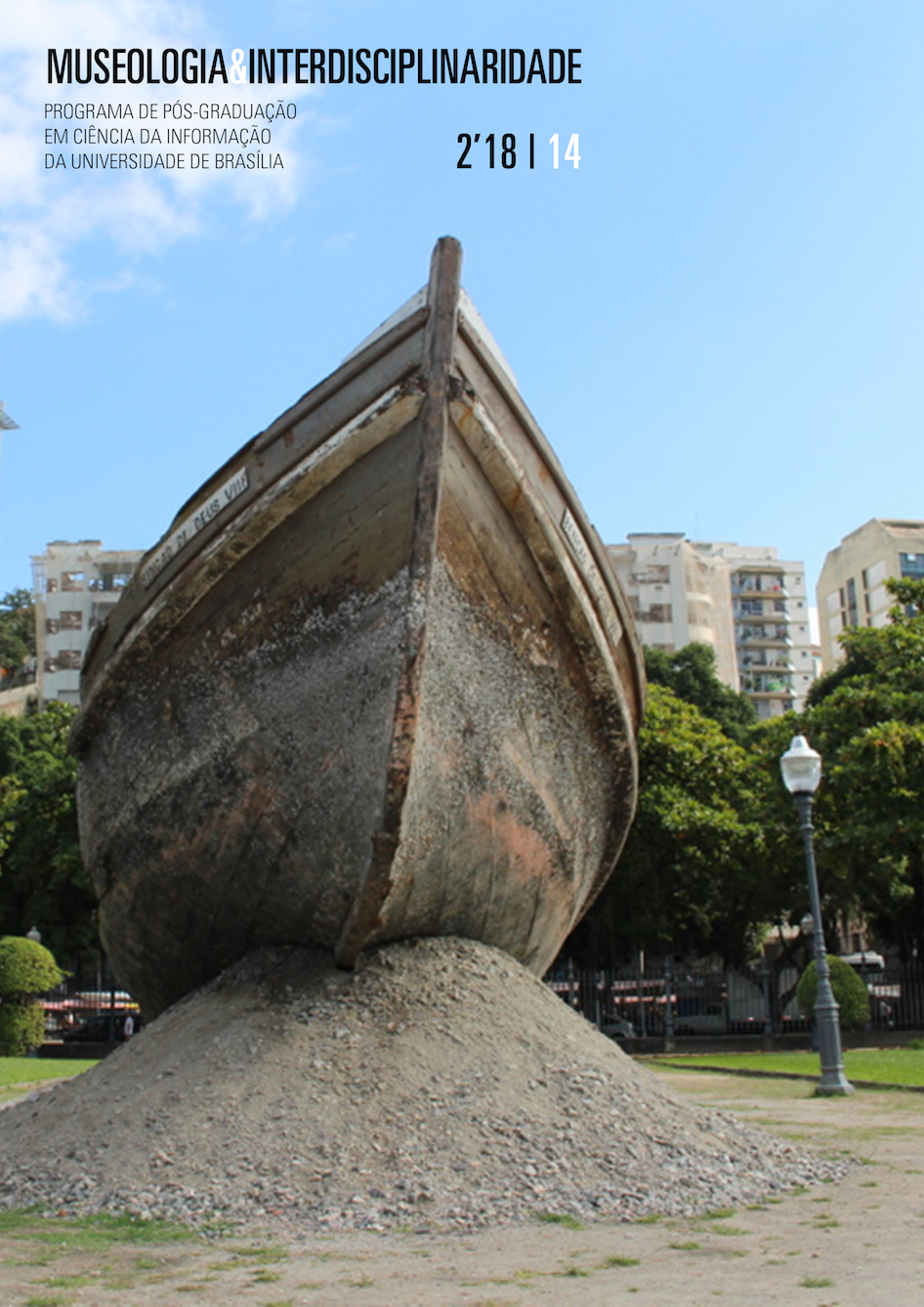Profundezas no céu
as fronteiras entre a técnica e os significados das baleias em museus de história natural
DOI:
https://doi.org/10.26512/museologia.v7i14.18391Palavras-chave:
MuseologiaResumo
Esqueletos e modelos de baleias são recorrentes em museus de história natural. A partir de uma coletânea de casos europeus e americanos, este display é utilizado como ferramenta de análise e interface entre campos do conhecimento. Por meio das discussões sobreos desafios expográficos impostos pela anatomia dos cetáceos é evidenciada a circulação de teorias, técnicas curatoriais, esquemas, objetose profissionais, temas pertinentes à História das Ciências. No âmbito da Museologia, é abordada polissemia dos objetos em exposições. Considerando que baleias suspensas estão presentes em exposições científicasdesde o século XIX, nota-se que os significados imbuídos transcendem a comunicação de conceitos científicos, remetendo a mitologias, pautas institucionais ou cultura de massa e fetiche, fatores que também determinam sua presença em exposições.
Downloads
Referências
BAE, Jaehan. 2013. “Saving Whales and Dolphins through Petroglyphs and Activist Artworks” Art Education, v. 66, n. 4, p. 28”“35, 2013.
BECKMAN, Jenny. “Nature’s Place: Constructing the Swedish Museum of Natural History.” History of ScienceHistory of Science, v. 42, n. 1, p.85”“111, 2004.
BENNETT, Tony. The Birth of the Museum: History, Theory, Politics. New York: Routledge, 1995.
BRITISH MUSEU (NATURAL HISTORY). A General Guide to the British Museum (Natural History): With Plans and a View of the Building. 1st Editio. London: William Clowes and Sons, Limited, 1882.
CONOVER, Adele. “The Object at Hand It.” Smithsonian Magazine. 1996. Disponível em: <https://www.smithsonianmag.com/science-nature/the-object-at-hand-5-123095016/>. Acesso em: 02 de dezembro de 2017.
DELICADO, Ana. “Microscópios, Batas Brancas E Tubos de Ensaio: Representações da Ciência Nas Exposições Científicas.” Revista Crítica de Ciências Sociais, v. 83, p. 79”“98, 2008.
DIAMOND, Judy, and EVANS, Margaret. “Museums Teach Evolution.” Evolution, v. 61, n. 6, p. 1500”“1506, 2007.
FARRO, Máximo. La formación del Museo de La Plata. Coleccionistas, comerciantes, estudiosos y naturalistas viajeros a fines del siglo XIX. Rosario: Prohistoria ediciones, 2009.
FORGAN, Sophie. “Building the Museum.” Isis, v. 96, n. 4, p. 572”“85, 2005.
GELDER, Richard G. Van. “Whale on My Back.” Curator: The Museum Journal, v. XII, n. 2, p.95”“118, 1970.
GRÖNBERG, Cecilia; MAGNUSSON, Jonas J. “The Gothenburg Leviathan.” Cabinet, no. 33:1”“9, 2009.
HENDRY, Alastair. 2017. “The Whale Story: Richard Owen.” Natural History Museum. 2017. Disponível em: http://www.nhm.ac.uk/discover/the-whale-story-richard-owen.html?utm_source=fb-image-post-20170119&utm_
medium=social&utm_campaign=hintze-hall. Acesso em: 10 de dezembro de 2017.
HENNING, Michelle. “Neurath´s Whale.” In The Afterlives of Animals: A Museum Menagerie, edited by Samuel J.M.M. Alberti. Charlottesville: University of Virginia Press, 2011. p. 151- 168.
JENKINS, Lekelia D. “OCEANS: Smithsonian Swims in New Direction.” Science, v. 322, n. 5904, p. 1053a, 2008.
LEMOINE, Gwenaël; GUILMINOT, Élodie. “La Problématique Du Dégraissage Des Squelettes.” La Lettre de l’OCIM: Musées, Patrimoine E Culture Scientifiques et Techniques, n. 122:12”“18, 2009.
LINDGREN, James M. “‘Let Us Idealize Old Types of Manhood’: The New Bedford Whaling Museum, 1903-1941.” The New England Quarterly, v. 72, n. 2, p. 163”“206, 1999.
LOPES, Maria Margaret. O Brasil descobre a pesquisa científica: as ciências naturais e os museus no século XIX. 2a. ed. São Paulo, Brasília: HUCITEC, UnB, 2009.
NAISH, Darren. 2014. “After 75 Years, 6-Ton Blue Whale Moel Still Excites London Museum.” Scientifican American, 2014. Disponível em: https://blogs.scientificamerican. com/tetrapod-zoology/after-75-years-6-ton-blue-whale-model-still-excites-london-museum/. Acesso em 5 de janeiro de 2018.
NATIONAL MUSEUM OF NATURAL HISTORY. “A Century of Whales at the Smithsonian Institution.” 2010. Disponível em https://naturalhistory.si.edu/onehundredyears/profiles/whales_si.html. Acesso em 23 de dezembro de 2017.
NATURAL HISTORY MUSEUM. “The Life of the Blue Whale.” 2017. Disponível em: http://www.nhm.ac.uk/bluewhale/. Acesso em 29 de dezembro de 2017.
NEURATH, Otto. “Museums of the Future.” Survey Graphics, n. 22, p. 458”“63, 1933.
NYHART, Lynn K. Modern Nature: The Rise of the Biological Perspective in Germany. Chicago: University of Chicago Press, 2009.
OSOSKY, John. “History of Collecting, Preparing and Degreasing Whale Skeletons at the Smithsonian Institution” 2012. Disponível em: < http://www.museum. nantes.fr/pages/21_activitesscientifiques/TableRonde_squelettes_fevrier2012/ PDF/J.%20Ososky%20-%20History%20od%20Collecting,%20Preparing%20...%20Smithsonian%20Institution.pdf>. Acesso em 03 de janeiro de 2018.
PARR, Albert Eide. “Concerning Whales and Museums.” Curator, v. VI, n. 1, p. 65”“76, 1963.
PODGORNY, Irina; LOPES, Maria Margaret. El Desierto en una vitrina : museos e historia natural en la Argentina : 1810-1890. 2a ed. Rosario: Prohistoria Ediciones, 2014.
QUINN, Stephen Christopher. Windows on Nature: The Great Habit Dioramas of the American Museum of Natural History. New York: ABRAMS, 2006.
RADER, Karen A.; CAIN, Victoria E.M. “From Natural History to Science: Display and the Transformation of American Museums of Science and Nature.” Museum and Society, v. 6, n. 2, p. 152”“71, 2008.
””””””. Life on Display: Revolutionizing U.S. Museums of Science & Natural History in the Twentieth Century. Chicago: The University of Chicago Press, 2014.
ROSSI, Michael. “Modeling the Unknown: How to Make a Perfect Whale.” Endeavour, v. 32, n. 2, p. 58”“63, 2008.
”””””” “Fabricating Authenticity: Modeling a Whale at the American Museum of Natural History, 1906”“1974.” Isis v. 101, n. 2, p. 338”“61, 2010.
RUDWICK, Martin J. S. 1992. Scenes from deep time. Early pictorial representations of the prehistoric world. Chicago: University of Chicago Press.
SHEETS-PYENSON, Susan. Cathedrals of Science. The Development of Colonial Natural History Museums during the Late Nineteenth Century. Kingston and Montreal: McGill-Queen’s University Press, 1998.
TRUE, Frederick W. “The British Museum of Natural History.” Science, v. 6, n. 132, p.127”“30, 1885.
Downloads
Publicado
Como Citar
Edição
Seção
Licença
Copyright (c) 2020 Museologia & Interdisciplinaridade

Este trabalho está licenciado sob uma licença Creative Commons Attribution-NonCommercial-NoDerivatives 4.0 International License.


